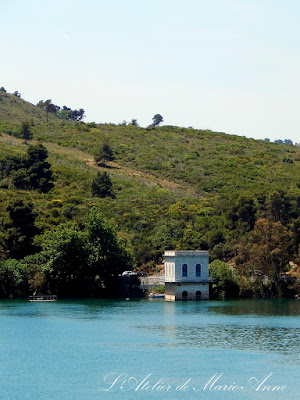As most of you surely know,Marathon is the area where the historical battle took place
between Greeks and Persians, in 490 B.C.
There lies the small town of Marathon with the famous Marathon Tomb, the burial mound for the Athenians lost in the battle.
The Marathon race is based on the legend from which it gained its name: Pheidippides, a messenger in Ancient Greece, ran from the Battle of Marathon to Athens to announce the Greeks' victory over the Persians.
The Athens Classic (authentic) Marathon is an annual marathon road race held in Athens, Greece, normally in early November. The race attracted 43.000 competitors in 2015 of which 16.000 were for the 42km course, both numbers being an all time record for the event. The rest of the runners competed in the concurrent 5 and 10km road races and the racewalking contest.
But, what you might not know, is that there is a Marathon Lake
and the famous Marathon Dam!
and the famous Marathon Dam!
This is were we drove to, last week and I thought you might be interested in getting to know this place.
We had not been to the Marathon Dam for many many years!!!
Last time we were there, it was about 25 years ago when our children were little and we used to spend our summer holidays close to the small town of Marathon.
We left the town of Marathon behind us, and drove up the mountains
until we reached the Dam.
The Marathon Damwas constructed at the confluence of the torrents Charadrοs and Varnavas, creating a huge reservoir of water, the Marathon Lake.
The construction of the arched dam began in 1926 and finished in 1929. It was built by U.S. company ULEN (which maintained by contract, the ownership of the water supply company of Athens until 1974).
Almost 2,000 people were employed. They were granted free accommodation and food to live in the area, throughout the period of the works.
For the completion of the project a long tunnel of about 13.5 Km was constructed, through which water was transported from Marathon to the city of Athens. A marble tower was also built controlling, with special valves, the flow of the water into the tunnel.
The dam was entirely covered with white marble from the Mount Penteli, the same Pentelic marble which was used in ancient times for the Parthenon on the Acropolis.
This makes the Marathon Dam unique and famous all over the world!
Before the construction of the dam was finished, a small ancient style temple was erected by the same workers at the base and just behind the massive walls of the dam.
It is a copy of the temple built by the Athenians in Delphi after their victory at the Battle of Marathon. Thus, the ‘modern’ temple symbolizes the victory of modern Athenians in their fight with water scarcity.
We enjoyed an iced coffee, or "café frappé", as we call it in Greece,
at the Fragma Café-Restaurant
(Fragma meaning Dam in Greek)
enjoying the splendid view over the Dam,
the lake
and the hills around it.
Then we walked over the dam, taking photos
and looking at the seagulls
and the big fish in the lake.
You can see how the passage way is very narrow. Just one car can cross on the single lane, while the cars on the opposite side of the Dam have to wait for the green traffic light allowing them to cross.
On our way back, we stopped to take some photos of a funny 'windmill' style country house
and to cut some yellow "stathouria",
as we call the common "curry plant" or Helichrysum Italicum.
they can last for years in a vase without any water.
We had a lovely day and enjoyed the good weather and the beautiful colours of the countryside.
I would have loved to see some lavender fields and feel as if I were in Provence in southern France, but...we are in Greece and a sight like this
is not usual!
This is why I am so pleased when I find a beautiful napkin to use for my decoupage!!!
Napkin relief decoupage, with acrylics and patinas.
You may read more on the history of Marathon and look at some beautiful pictures here:

































Δεν υπάρχουν σχόλια:
Δημοσίευση σχολίου